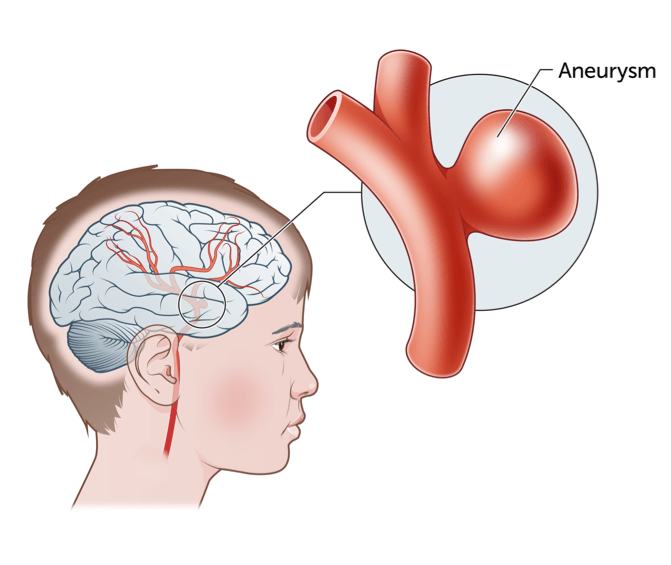A brain aneurysm, also known as a subarachnoid hemorrhage (SAH), is a weak spot in the wall of a blood vessel inside the brain. Think of a weak spot in a balloon and how it feels stretched out and thin. A brain aneurysm is like that.
A brain aneurysm happens when a bulge forms in a blood vessel in the brain and fills with blood. Aneurysms often produce no symptoms unless they burst open or leak blood. A ruptured aneurysm causes severe headache and can lead to a fatal stroke. Treatments include different methods to stop blood from entering the aneurysm and diverting blood flow over the aneurysm.
That area of the blood vessel gets worn out from constant flow of blood and bulges out, almost like a bubble. It can grow to the size of a small berry.
There are different types:
Saccular aneurysms are the most common type of brain aneurysm. They bulge out in a dome shape from the main artery. They’re connected to that artery by a narrow “neck.”
Fusiform aneurysms aren’t as common as saccular aneurysms. They don’t pouch out in a dome shape. Instead, they make a widened spot in the blood vessel.
Although brain aneurysms sound alarming, most don’t cause symptoms or health problems. You can enjoy a long life without ever realizing that you have one.
But in rare cases, aneurysms can grow big, leak, or explode. Bleeding in the brain, known as a hemorrhagic stroke, is serious, and you’ll need medical care right away.

Brain Aneurysm Symptoms
The type of symptoms you have from a brain aneurysm depend on whether it ruptures or not.
Ruptured brain aneurysm symptoms :
You need emergency care if you suddenly get an intensely painful headache, lose consciousness, or have some of these other symptoms of an aneurysm rupture:
- Intense headache that comes on suddenly
- Loss of consciousness
- Nausea and vomiting
- Drowsiness
- Loss of balance in things like walking and normal coordination
- Stiff neck
- Dilated pupils
- Sensitivity to light
- Sudden blurred or double vision
- Drooping eyelid
- Confusion or trouble with mental awareness
- Seizure
Although brain aneurysms usually don’t show symptoms, they can press on the brain and nerves as they get bigger.
Unruptured brain aneurysm symptoms :
See a doctor at once if you’re having the following symptoms of an unruptured aneurysm:
- Headache
- Dilated pupils
- Blurred or double vision
- Pain above and behind an eye
- Drooping eyelid
- A hard time speaking
- Weakness and numbness in one side of your face
A sudden and intense headache can also be a sign you have a leaking aneurysm (sentinel bleed). This can be a sign you’ll soon have a full rupture.

What causes brain aneurysms?
It’s not clear why a brain aneurysm forms. Researchers believe these factors irritate and weaken blood vessels:
- Smoking.
- Blood infection.
- High blood pressure (hypertension).
- Amphetamine and cocaine use.
- Traumatic brain injury (often caused by car crashes).
- Atherosclerosis (fatty buildup on blood-vessel walls).




